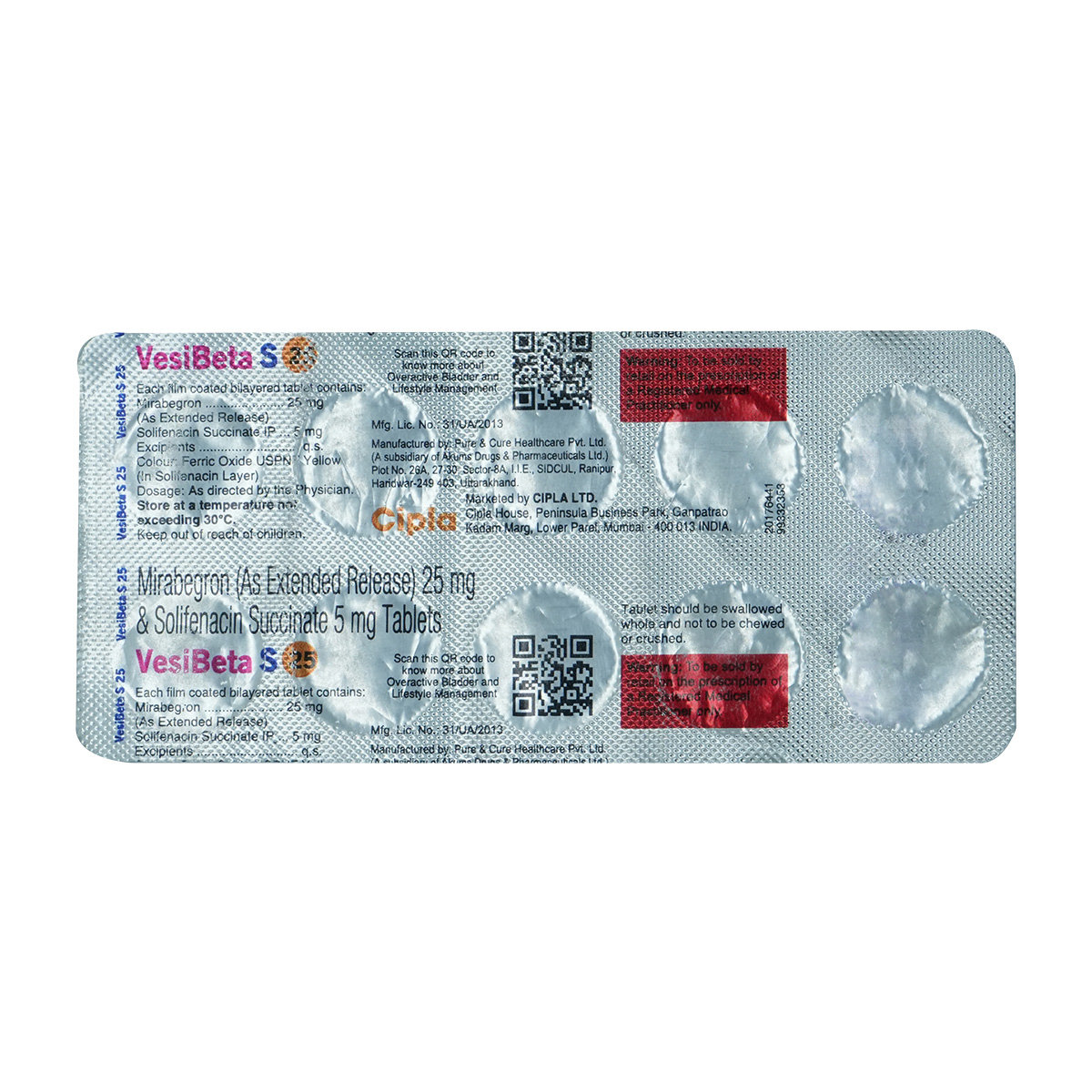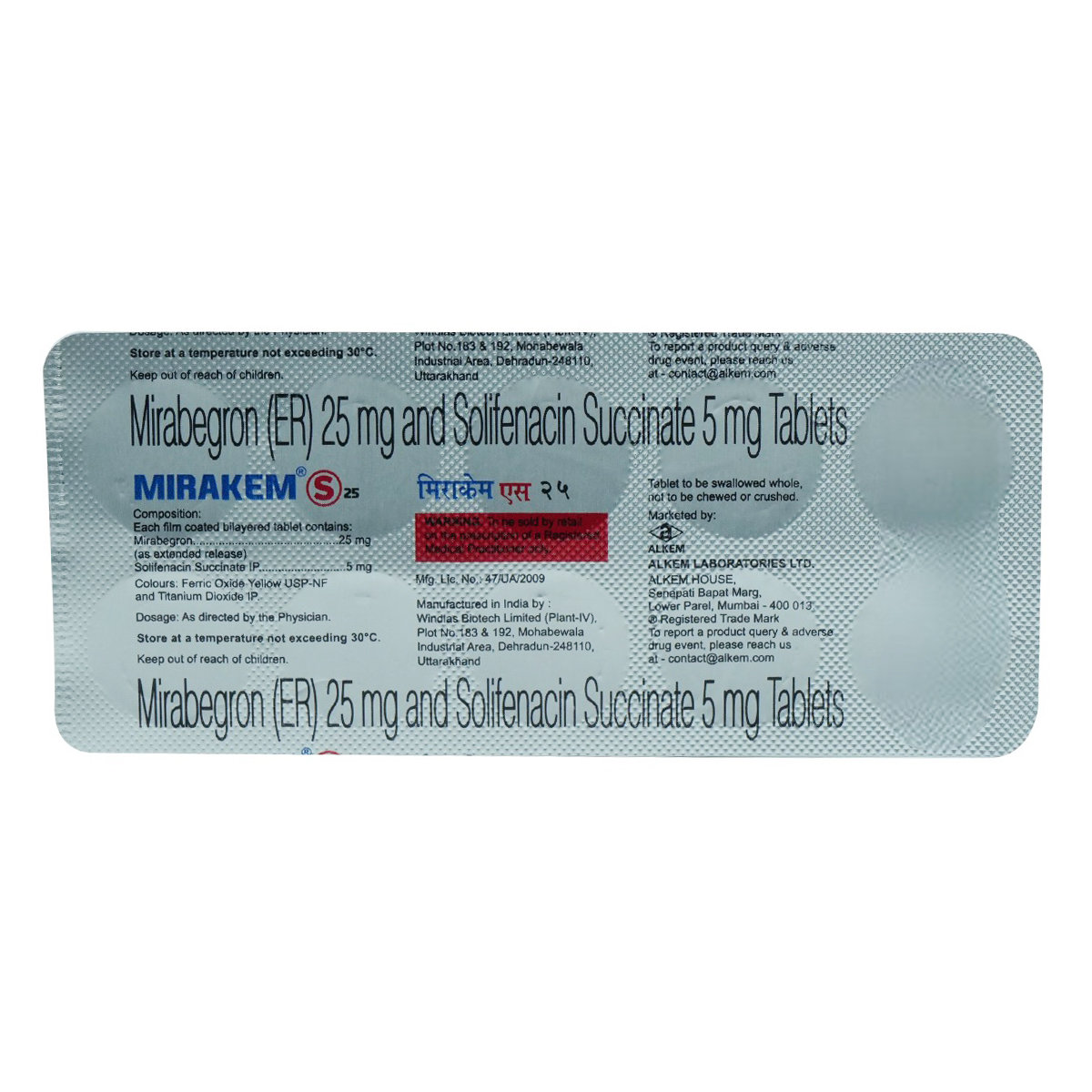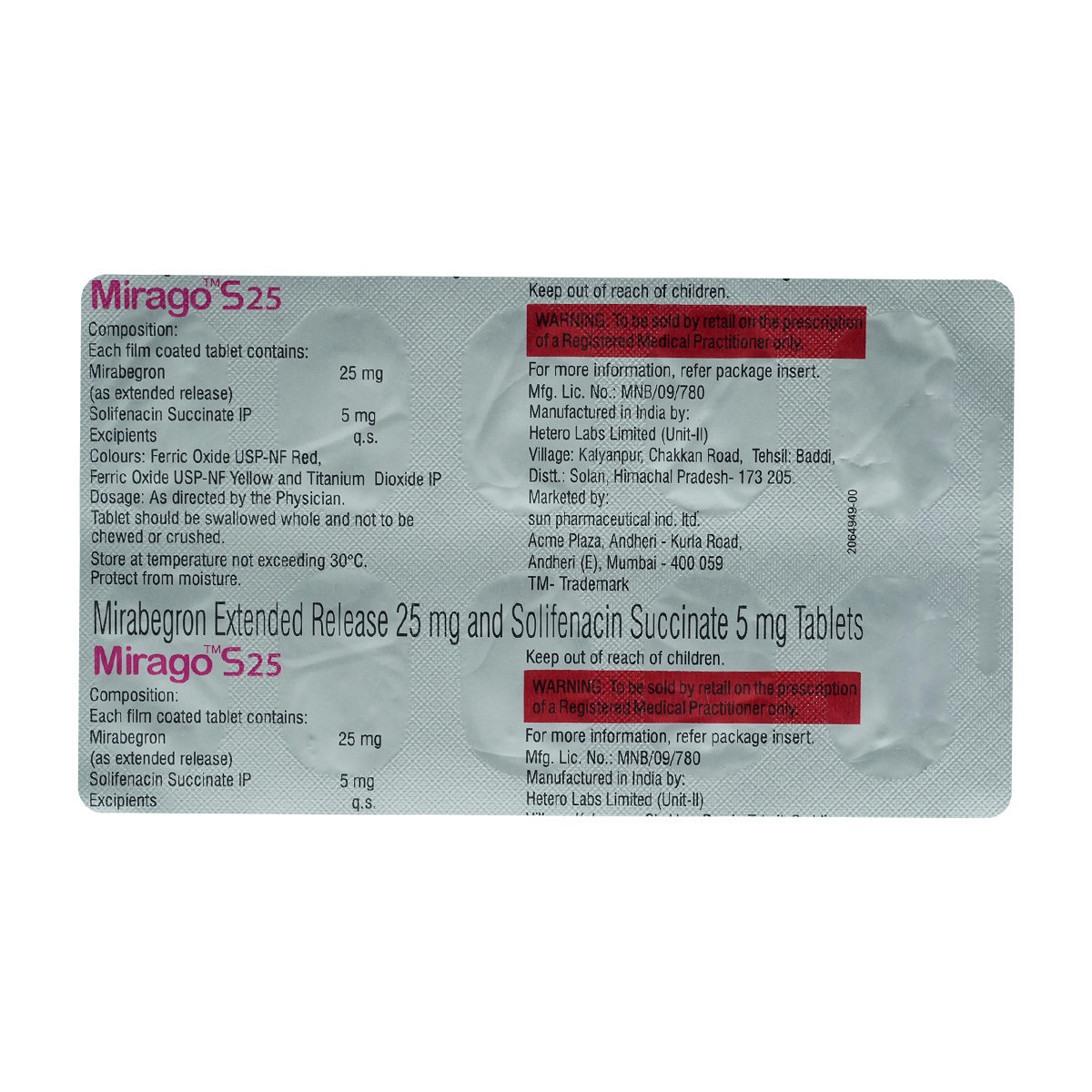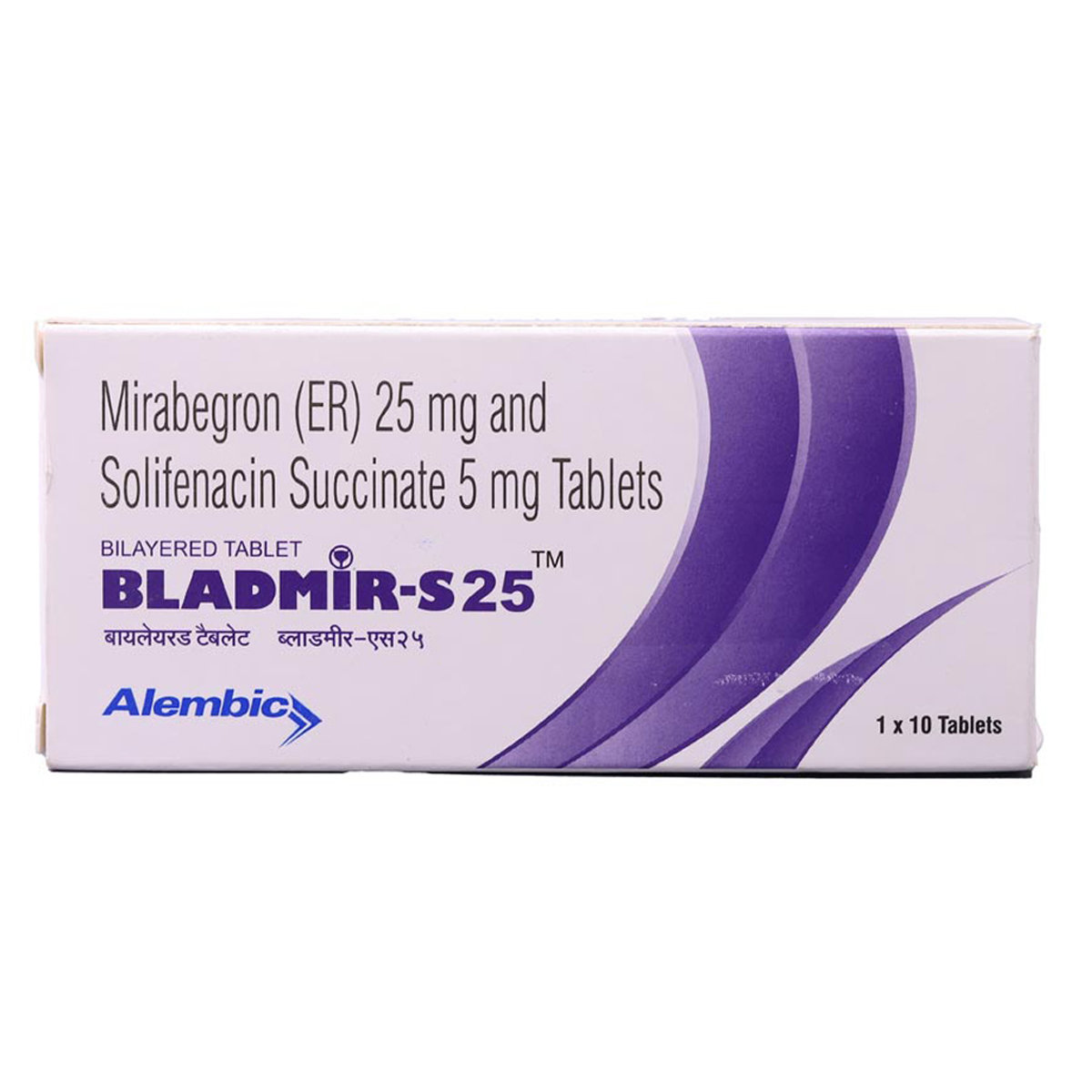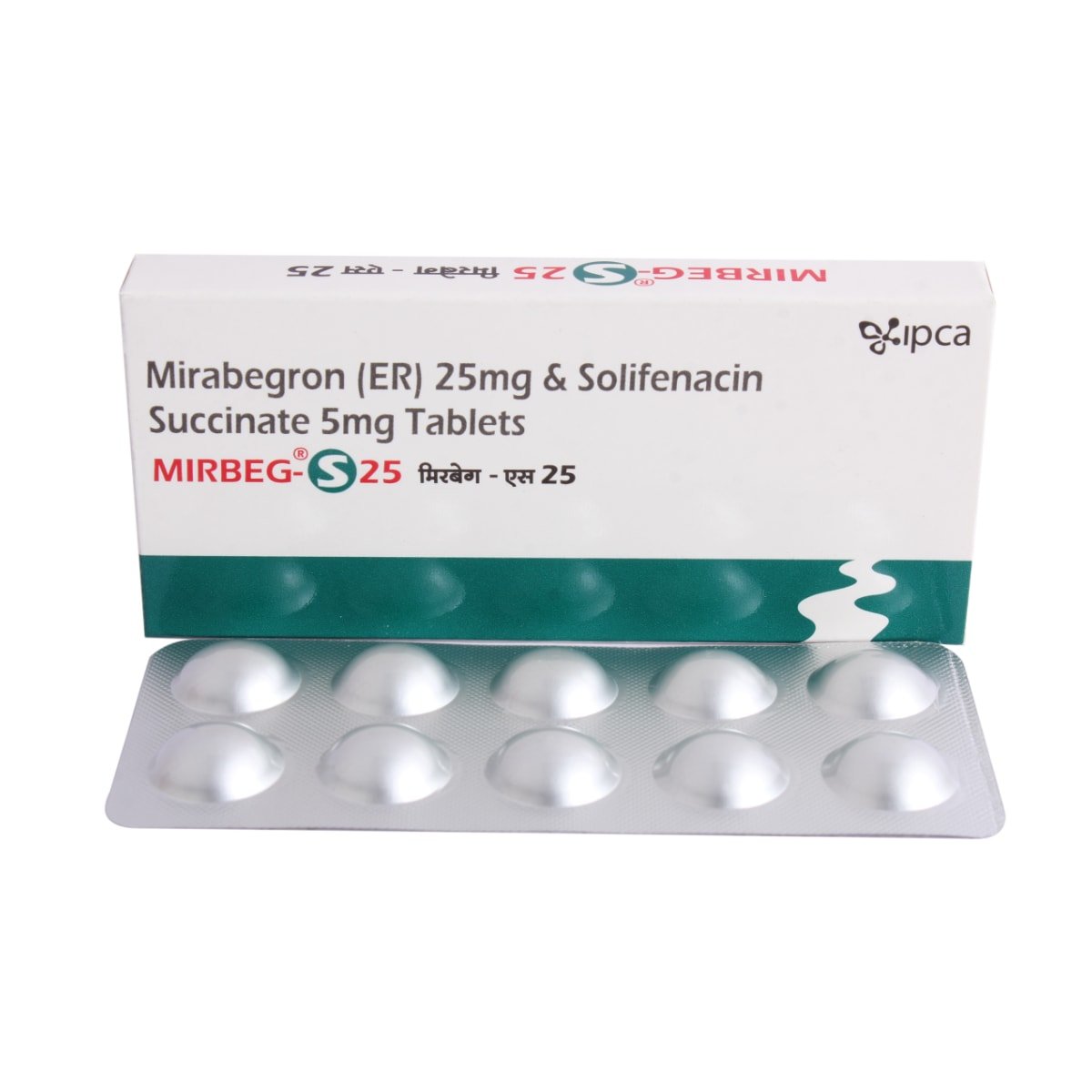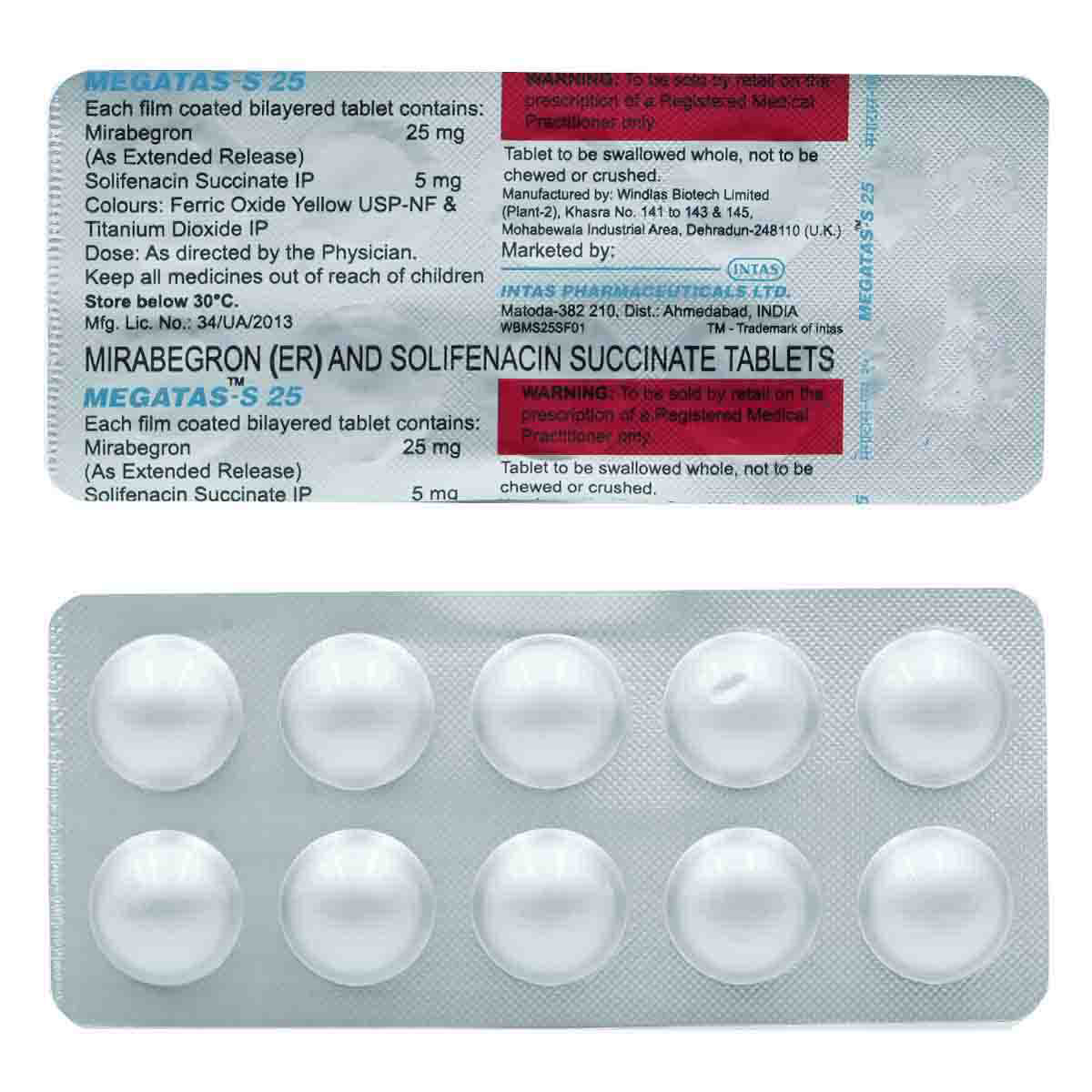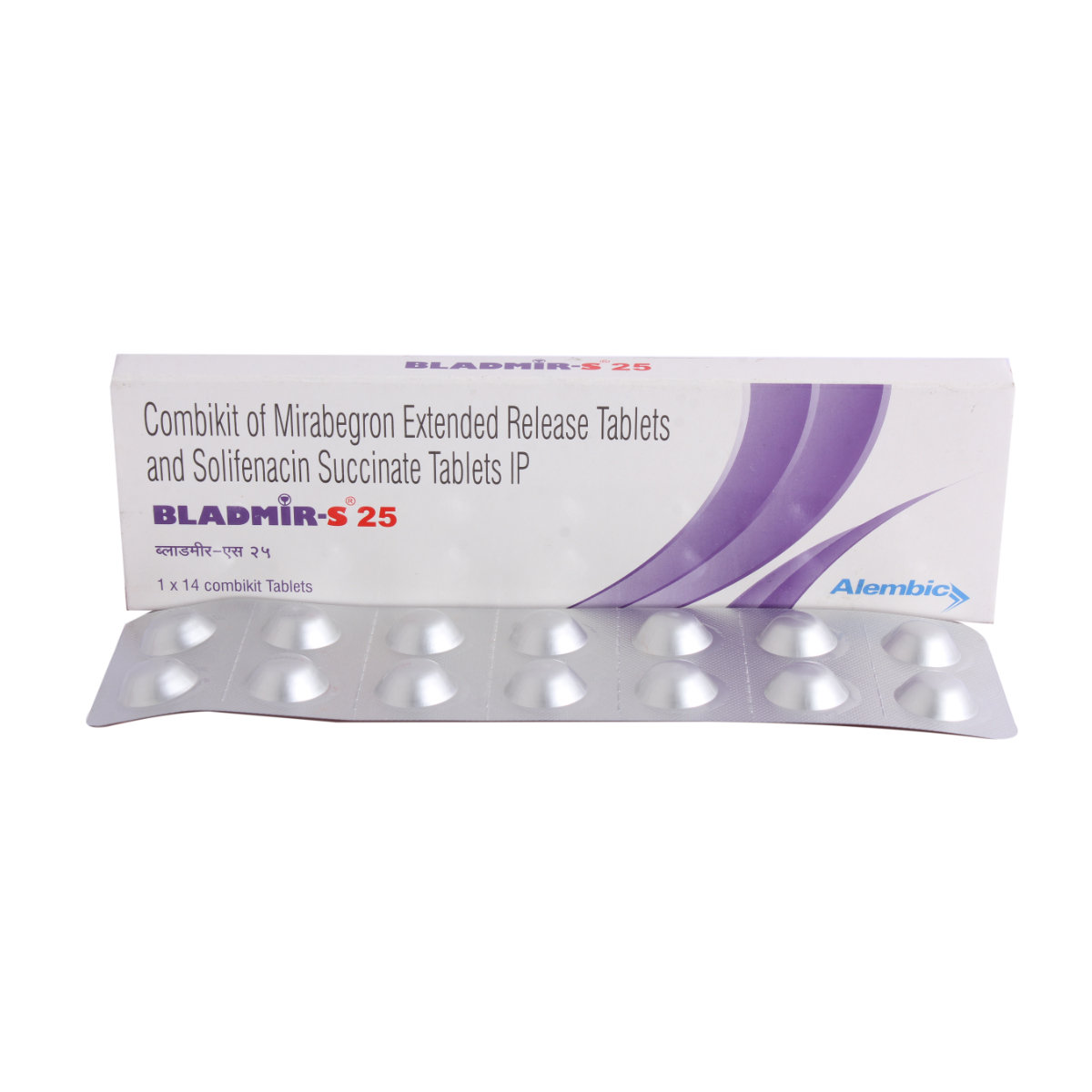Mirbeg-S 25mg Combikit Tablet

MRP ₹442
(Inclusive of all Taxes)
₹66.3 Cashback (15%)
know your delivery time
Provide Delivery Location
Composition :
Manufacturer/Marketer :
Consume Type :
Expires on or after :
Return Policy :

Secure Payment

Trusted by 8 Crore Indians

Genuine Products
Therapeutic Class
Country of origin
Manufacturer/Marketer address
Author Details
We provide you with authentic, trustworthy and relevant information
Disclaimer
Alcohol
Safe if prescribed
You are recommended to avoid or limit alcohol consumption while taking Mirbeg-S 25mg Combikit Tablet as it may cause increased dizziness.
Pregnancy
Consult your doctor
Limited information is available regarding the usage of Mirbeg-S 25mg Combikit Tablet during pregnancy. Consult your doctor before taking Mirbeg-S 25mg Combikit Tablet if you are pregnant.
Breast Feeding
Consult your doctor
Limited information is available regarding the usage of Mirbeg-S 25mg Combikit Tablet during breastfeeding. Consult your doctor before taking Mirbeg-S 25mg Combikit Tablet if you are breastfeeding.
Driving
Safe if prescribed
Mirbeg-S 25mg Combikit Tablet may cause blurred vision and tiredness. Drive or operate machinery only if you are alert.
Liver
Consult your doctor
Please consult your doctor if you have a liver impairment or any concerns regarding this.
Kidney
Consult your doctor
Please consult your doctor if you have kidney impairment or any concerns regarding this.
Children
Safe if prescribed
Mirbeg-S 25mg Combikit Tablet is not recommended for children as safety and effectiveness have not been established.
Product Substitutes
About Mirbeg-S 25mg Combikit Tablet
Mirbeg-S 25mg Combikit Tablet is a combination medicine used to treat overactive bladder (OAB) with symptoms of urinary incontinence (urine leakage), urgent or frequent urination, increased night-time urination, and dysuria (painful or difficult urination). Overactive bladder is a condition in which there is a problem with bladder function, which causes a sudden urge to urinate that might be difficult to control.
Mirbeg-S 25mg Combikit Tablet contains Solifenacin (anti-cholinergic) and Mirabegron (beta-3 adrenergic agonist). Solifenacin reduces the undesirable contractions of the bladder, thereby increasing the amount of urine that the bladder can hold. This decreases the urgency for urination. Mirabegron relaxes the muscles of the bladder; this prevents frequent, uncontrolled, or urgent urination. Together, Mirbeg-S 25mg Combikit Tablet helps in treating overactive bladder.
You are advised to take Mirbeg-S 25mg Combikit Tablet for as long as your doctor has prescribed it for you, depending on your medical condition. In some cases, you may experience common side-effects such as dry mouth, constipation, headache, high blood pressure, and vomiting. Most of these side effects do not require medical attention and will resolve gradually over time. However, you are advised to talk to your doctor if you experience these side effects persistently.
Consult your doctor if you are pregnant or breastfeeding. Mirbeg-S 25mg Combikit Tablet is not recommended for children as safety and efficacy have not been established. Mirbeg-S 25mg Combikit Tablet may cause blurred vision, so drive with caution. Avoid or limit alcohol consumption along with Mirbeg-S 25mg Combikit Tablet as it could lead to increased dizziness. Inform your doctor about your health condition and medications before taking Mirbeg-S 25mg Combikit Tablet to rule out any side effects/interactions.
Uses of Mirbeg-S 25mg Combikit Tablet
Medicinal Benefits Mweb
Key Benefits
Mirbeg-S 25mg Combikit Tablet is a combination of two drugs, namely: Solifenacin and Mirabegron. Mirbeg-S 25mg Combikit Tablet is a combination medicine used to treat overactive bladder (OAB) with symptoms of urinary incontinence (urine leakage), urgent or frequent urination, increased night-time urination, dysuria (painful or difficult urination). Solifenacin is an anti-cholinergic that reduces the undesirable contractions of the bladder, thereby increasing the amount of urine that the bladder can hold. This decreases the urgency for urination. Mirabegron is a beta-3 adrenergic agonist which relaxes the muscles of the bladder; this prevents frequent, uncontrolled, or urgent urination. Together, Mirbeg-S 25mg Combikit Tablet helps in treating an overactive bladder.
Directions for Use
Side Effects of Mirbeg-S 25mg Combikit Tablet
- Constipation
- Headache
- Dry mouth
- Blurred vision
- Vomiting
- High blood pressure
- Urinary tract infection
Drug Warnings
Do not take Mirbeg-S 25mg Combikit Tablet if you are allergic to any of its contents. Inform your doctor if you have glaucoma, myasthenia gravis, ulcerative colitis, urinary retention, high blood pressure, angioedema, kidney or liver problems. Consult your doctor if you are pregnant or breastfeeding. Mirbeg-S 25mg Combikit Tablet is not recommended for children. Mirbeg-S 25mg Combikit Tablet may cause blurred vision, so drive with caution. Avoid or limit alcohol consumption with Mirbeg-S 25mg Combikit Tablet as it could lead to increased dizziness.
Drug-Drug Interactions
Drug-Drug Interactions
Login/Sign Up
Coadministration of Eliglustat and Mirbeg-s 25mg Combikit Tab can significantly increase the blood levels of eliglustat. This can increase the risk or severity of side effects.
How to manage the interaction:
Taking Mirbeg-s 25mg Combikit Tab with Eliglustat is not recommended, it should be taken only when advised by a doctor. You should seek immediate medical help if you develop symptoms like sudden dizziness, lightheadedness, fainting, shortness of breath, irregular heart rate, weak pulse, or heart palpitations. Do not discontinue any medications without a doctor's advice.
Using Mesoridazine together with Mirbeg-s 25mg Combikit Tab can increase the risk of an irregular heart rhythm.
How to manage the interaction:
Taking Mesoridazine with Mirbeg-s 25mg Combikit Tab is not recommended, please consult your doctor before taking it. You should seek immediate medical attention if you develop sudden dizziness, lightheadedness, fainting, shortness of breath, or heart palpitations call a doctor.
Taking Mirbeg-s 25mg Combikit Tab and Potassium chloride together can increase the risk of stomach ulcers, bleeding, and stomach injury.
How to manage the interaction:
Taking Mirbeg-s 25mg Combikit Tab with Potassium chloride is not recommended, as it can lead to an interaction, it can be taken if a doctor has prescribed it. However, if you experience severe stomach pain, bloating, sudden lightheadedness or dizziness, nausea, vomiting (especially with blood), decreased hunger, dark, tarry stools, consult the doctor immediately. Do not discontinue any medications without a doctor's advice.
The blood levels and effects of Mirbeg-s 25mg Combikit Tab may be greatly increased when combined with itraconazole.
How to manage the interaction:
Mirbeg-s 25mg Combikit Tab and Itraconazole may interact, however, if recommended by a physician, they are safe to consume. Consult a doctor if you feel sleepy, or uneasy, have an irregular heartbeat, have blurry vision, have trouble urinating, have a dry mouth, a headache, have digestive problems, or have constipation. Without consulting a doctor, never stop taking any medication.
Combined use of Mirbeg-s 25mg Combikit Tab and Pimozide may increase the level of pimozide in the blood. This can increase the risk or severity of irregular heart rhythms.
How to manage the interaction:
Taking Mirbeg-s 25mg Combikit Tab and Pimozide may lead to an interaction but they can be taken together if your doctor has prescribed them. However, if you experience drowsiness, blurred vision, dry mouth, constipation, low blood pressure, tremors, trembling of hands, arms, legs, jaw and face, balance and Speech difficulty, or abnormal muscle movements consult a doctor. Do not discontinue any medications without consulting a doctor.
Coadministration of Mirbeg-s 25mg Combikit Tab and Venetoclax may significantly increase the blood levels and effects of Venetoclax. This can increase the risk or severity of side effects.
How to manage the interaction:
There may be a possible interaction between Mirbeg-s 25mg Combikit Tab and Venetoclax, but they can be taken together if your doctor has prescribed them. However, if you experience nausea, vomiting, diarrhea, fatigue, fever, chills, bleeding problems, sudden dizziness, lightheadedness, fainting, shortness of breath, or rapid heartbeat, contact a doctor immediately. Do not discontinue any medications without consulting a doctor.
Combine use of Mirbeg-s 25mg Combikit Tab and thioridazine may raise the blood levels of thioridazine. This can increase the risk or severity of side effects.
How to manage the interaction:
Taking Mirbeg-s 25mg Combikit Tab and thioridazine together can possibly result in an interaction, it can be taken if your doctor has advised it. However, if you experience stomach pain, diarrhea, dehydration, sudden dizziness, lightheadedness, fainting, shortness of breath, or rapid heartbeat, contact a doctor immediately. Do not discontinue any medications without consulting a doctor.
Coadministration of Mirbeg-s 25mg Combikit Tab and Tamoxifen may reduce the effects of tamoxifen.
How to manage the interaction:
Taking Mirbeg-s 25mg Combikit Tab and Tamoxifen together can possibly result in an interaction, it can be taken if your doctor has advised it. However, if you experience painful urination, constipation, dry mouth, headache, sudden dizziness, lightheadedness, fainting, shortness of breath, or rapid heartbeat, contact a doctor immediately. Do not discontinue any medications without consulting a doctor.
Combining Aripiprazole with Mirbeg-s 25mg Combikit Tab can increase the levels of Aripiprazole in the body. This can lead to increased risk or severity of side effects.
How to manage the interaction:
Although taking Mirbeg-s 25mg Combikit Tab and Aripiprazole together can cause an interaction, it can be taken if a doctor has suggested it. If you notice any of these signs like feeling sleepy, having seizures, unusual muscle movements, low blood pressure, feeling confused, muscle spasms, twitching in your jaw, shaking or jerking in your arms and legs, feeling nervous or restless, dizziness, lightheaded, or fainting contact the doctor right away. Do not stop using any medications without a doctor's advice.
A combined use of Mirbeg-s 25mg Combikit Tab and Brexpiprazole may increase the level of Brexpiprazole in blood. This can increase the risk or severity of side effects.
How to manage the interaction:
There could be a possible interaction between Mirbeg-s 25mg Combikit Tab and Brexpipraole, it can be taken together if your doctor has advised them. However, if you experience drowsiness, fatigue, seizure, chest pain or tightness, irregular heart rates, fever, excessive sweating, shivering or shaking, blurred vision, muscle spasm or stiffness, tremors, incoordination, stomach cramp, nausea, vomiting, and diarrhea contact a doctor immediately. Do not discontinue any medications without consulting a doctor.
Drug-Food Interactions
Drug-Food Interactions
Login/Sign Up
Drug-Diseases Interactions
Drug-Diseases Interactions
Login/Sign Up
Drug-Drug Interactions Checker List
- DIPHENHYDRAMINE
- METOPROLOL
- ACETAMINOPHEN
- ALBUTEROL
Habit Forming
Diet & Lifestyle Advise
- Pelvic floor exercises would be helpful in treating bladder spasms.
- Avoid foods like sugars, carbonated beverages, tea, citrus fruits, tomatoes, spicy foods, chocolate and tea.
- Avoid drinking excess alcohol or caffeinated drinks, as they can worsen the symptoms.
- Maintain a healthy weight, and exercise regularly.
- Quit smoking.
- Take 6-8glasses of liquids every day.
- Avoid processed foods. Instead, choose whole, unprocessed foods.
- Include fruits, vegetables, and fibre-rich food in your diet.
All Substitutes & Brand Comparisons
RX
Urihold S 25 Tablet 10's
Aristo Pharmaceuticals Pvt Ltd
₹168.5
(₹16.85 per unit)
95% CHEAPERRX
Out of StockSoliact M 25 Tablet 10's
Cipla Ltd
₹257.5
(₹23.18 per unit)
94% CHEAPERRX
Exena-S 25/5 Tablet 10's
Dr Reddy's Laboratories Ltd
₹283.5
(₹25.52 per unit)
93% CHEAPER

Have a query?
Buy best Genito Urinary products by
Cipla Ltd
Sun Pharmaceutical Industries Ltd
Intas Pharmaceuticals Ltd
Ipca Laboratories Ltd
Leeford Healthcare Ltd
Dr Reddy's Laboratories Ltd
Lupin Ltd
Alkem Laboratories Ltd
Msn Laboratories Pvt Ltd
Zydus Healthcare Ltd
Demorbus India Pvt Ltd
Mankind Pharma Pvt Ltd
Overseas Health Care Pvt Ltd
RPG Life Sciences Ltd
La Renon Healthcare Pvt Ltd
Alembic Pharmaceuticals Ltd
Corona Remedies Pvt Ltd
Macleods Pharmaceuticals Ltd
Aristo Pharmaceuticals Pvt Ltd
Fourrts India Laboratories Pvt Ltd
Tas Med India Pvt Ltd
Micro Labs Ltd
Samarth Life Sciences Pvt Ltd
Zydus Cadila
Emcure Pharmaceuticals Ltd
Hetero Drugs Ltd
Ignyx Pharmaceuticals
Renspur Healthcare Pvt Ltd
Steris Healthcare
Alniche Life Sciences Pvt Ltd
Septalyst Lifesciences Pvt Ltd
Ajanta Pharma Ltd
Elder Pharmaceuticals Ltd
Merynova Life Sciences India Pvt Ltd
Tppl Pharmaceuticals Pvt Ltd
Walter Bushnell
Aar Ess Remedies Pvt Ltd
Knoll Healthcare Pvt Ltd
Lividus Pharmaceuticals Pvt Ltd
Meditrex Pharma
Medrhans Pharmaceuticals Pvt Ltd
Neuten HealthCare
Redmed Medical Services
Talohsty Medmark Pvt Ltd
Zycris Healthcare
East West Pharma India Pvt Ltd
Globus Remedies Ltd
Golden Square Lab Pvt Ltd
Hetero Healthcare Pvt Ltd
Modi Mundipharma Pvt Ltd
Nephurocare Pharma Pvt Ltd
Pfizer Ltd
TTK Healthcare Ltd
Votary Laboratories (India) Ltd
Albus Healthcare Pvt Ltd
Delvin Formulations (P) Ltd
Indoco Remedies Ltd
Intra Life Pvt Ltd
Megma Healthcare Pvt Ltd
Morepen Laboratories Ltd
Qren Life Sciences Pvt Ltd
Steadfast MediShield Pvt Ltd
Unipark Biotech Pvt Ltd
Akumentis Healthcare Ltd
Biokindle Lifesciences Pvt Ltd
Calren Care Lifesciences Pvt Ltd
Chemo Biological Ltd
Chemo Healthcare Pvt Ltd
Euniche Life Sciences
Himeros Pharmaceuticals Pvt Ltd
Hospimax Healthcare Pvt Ltd
Kiosence Health Care Pvt Ltd
Lia Life Sciences Pvt Ltd
Panacea Biotec Ltd
Primus Remedies Pvt Ltd
Rencord Life Sciences Pvt Ltd
Shilpa Medicare Ltd
Stadmed Pvt Ltd
Abbott India Ltd
Ameya Pharmaceuticals & Chemicals Pvt Ltd
Ardent Life Sciences Pvt Ltd
Asterima Pharmaceuticals Pvt Ltd
Astrum Healthcare Pvt Ltd
Cadila Healthcare Ltd
De Renon
Fibovil Pharmaceuticals Pvt Ltd
Koye Pharmaceuticals Pvt Ltd
Linux Laboratories Pvt Ltd
MMC Healthcare Ltd
Neovae Biomedics Pvt Ltd
Olcare Laboratories Pvt Ltd
Oxygen Pharma Care Pvt Ltd
Prevego Healthcare & Research Pvt Ltd
Rene Lifescience
Sanzyme Pvt Ltd
Solis Ortus Remedies Pvt Ltd
Syndicate Life Sciences Pvt Ltd
Tycoon Pharmaceuticals Pvt Ltd
Vasu Organics Pvt Ltd
Walron Health Care Pvt Ltd
Frequently Bought Together
Customers Also Bought

_0.jpg?tr=q-85)



